Intel Iris Pro 5200 Graphics Review: Core i7-4950HQ Tested
by Anand Lal Shimpi on June 1, 2013 10:01 AM ESTCompute Performance
With Haswell, Intel enables full OpenCL 1.2 support in addition to DirectX 11.1 and OpenGL 4.0. Given the ALU-heavy GPU architecture, I was eager to find out how well Iris Pro did in our compute suite.
As always we'll start with our DirectCompute game example, Civilization V, which uses DirectCompute to decompress textures on the fly. Civ V includes a sub-benchmark that exclusively tests the speed of their texture decompression algorithm by repeatedly decompressing the textures required for one of the game’s leader scenes. While DirectCompute is used in many games, this is one of the only games with a benchmark that can isolate the use of DirectCompute and its resulting performance.
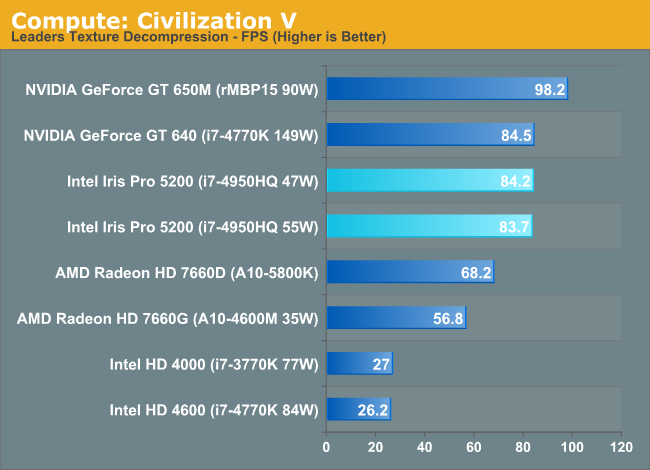
Iris Pro does very well here, tying the GT 640 but losing to the 650M. The latter holds a 16% performance advantage, which I can only assume has to do with memory bandwidth given near identical core/clock configurations between the 650M and GT 640. Crystalwell is clearly doing something though because Intel's HD 4600 is less than 1/3 the performance of Iris Pro 5200 despite having half the execution resources.
Our next benchmark is LuxMark2.0, the official benchmark of SmallLuxGPU 2.0. SmallLuxGPU is an OpenCL accelerated ray tracer that is part of the larger LuxRender suite. Ray tracing has become a stronghold for GPUs in recent years as ray tracing maps well to GPU pipelines, allowing artists to render scenes much more quickly than with CPUs alone.
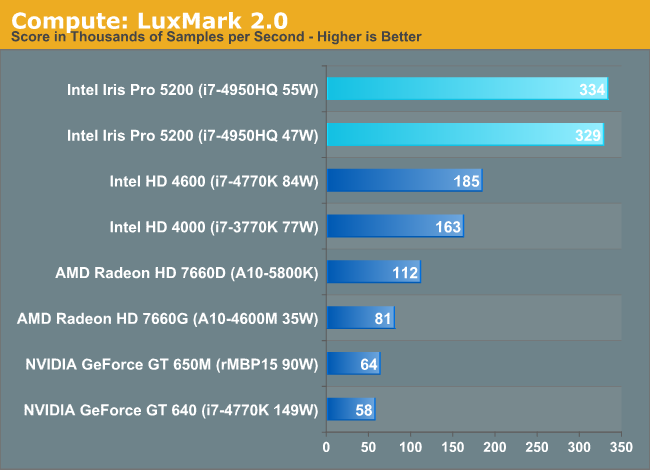
Moving to OpenCL, we see huge gains from Intel. Kepler wasn't NVIDIA's best compute part, but Iris Pro really puts everything else to shame here. We see near perfect scaling from Haswell GT2 to GT3. Crystalwell doesn't appear to be doing much here, it's all in the additional ALUs.
Our 3rd benchmark set comes from CLBenchmark 1.1. CLBenchmark contains a number of subtests; we’re focusing on the most practical of them, the computer vision test and the fluid simulation test. The former being a useful proxy for computer imaging tasks where systems are required to parse images and identify features (e.g. humans), while fluid simulations are common in professional graphics work and games alike.
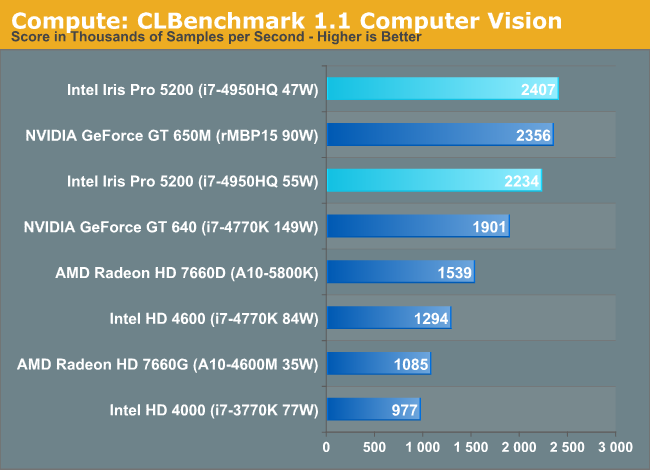
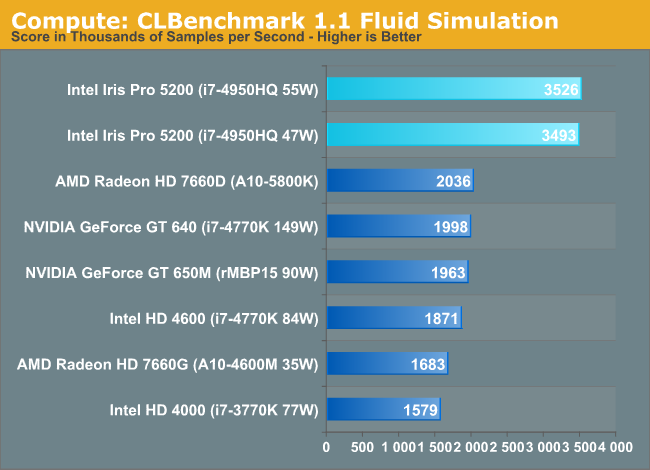
Once again, Iris Pro does a great job here, outpacing everything else by roughly 70% in the Fluid Simulation test.
Our final compute benchmark is Sony Vegas Pro 12, an OpenGL and OpenCL video editing and authoring package. Vegas can use GPUs in a few different ways, the primary uses being to accelerate the video effects and compositing process itself, and in the video encoding step. With video encoding being increasingly offloaded to dedicated DSPs these days we’re focusing on the editing and compositing process, rendering to a low CPU overhead format (XDCAM EX). This specific test comes from Sony, and measures how long it takes to render a video.
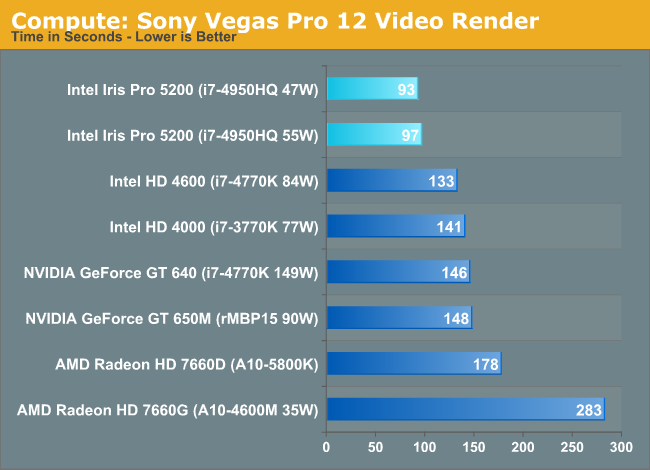
Iris Pro rounds out our compute comparison with another win. In fact, all of the Intel GPU solutions do a good job here.










177 Comments
View All Comments
s2z.domain@gmail.com - Friday, February 21, 2014 - link
I wonder where this is going. Yes the multi core and cache on hand and graphics may be goody, ta.But human interaction in actual products?
I weigh in at 46kg but think nothing of running with a Bergen/burden of 20kg so a big heavy laptop with ingratiated 10hr battery and 18.3" would be efficacious.
What is all this current affinity with small screens?
I could barely discern the vignette of the feathers of a water fowl at no more than 130m yesterday, morning run in the Clyde Valley woodlands.
For the "laptop", > 17" screen, desktop 2*27", all discernible pixels, every one of them to be a prisoner. 4 core or 8 core and I bore the poor little devils with my incompetence with DSP and the Julia language. And spice etc.
P.S. Can still average 11mph @ 50+ years of age. Some things one does wish to change. And thanks to the Jackdaws yesterday morning whilst I was fertilizing a Douglas Fir, took the boredom out of a another wise perilous predicament.
johncaldwell - Wednesday, March 26, 2014 - link
Hello,Look, 99% of all the comments here are out of my league. Could you answer a question for me please? I use an open source 3d computer animation and modeling program called Blender3d. The users of this program say that the GTX 650 is the best GPU for this program, siting that it works best for calculating cpu intensive tasks such as rendering with HDR and fluids and other particle effects, and they say that other cards that work great for gaming and video fall short for that program. Could you tell me how this Intel Iris Pro would do in a case such as this? Would your test made here be relevant to this case?
jadhav333 - Friday, July 11, 2014 - link
Same here johncaldwell. I would like to know the same.I am a Blender 3d user and work on cycles render which also uses the GPU to process its renders. I am planning to invest in a new workstation.. either a custome built hardware for a linux box or the latest Macbook Pro from Apple. In case of latter, how useful will it be, in terms of performance for GPU rendering on Blender.
Anyone care to comment on this, please.
HunkoAmazio - Monday, May 26, 2014 - link
Wow I cant believe I understood this, My computer archieture class paid off... except I got lost when they were talking about n1 n2 nodes.... that must have been a post 2005 feature in CPU N bridge S Bridge TechnologysystemBuilder - Tuesday, August 5, 2014 - link
I don't think you understand the difference between DRAM circuitry and arithmetic circuitry. A DRAM foundry process is tuned for high capacitance so that the memory lasts longer before refresh. High capacitance is DEATH to high-speed circuitry for arithmetic execution, that circuitry is tuned for very low capacitance, ergo, tuned for speed. By using DRAM instead of SRAM (which could have been built on-chip with low-capacitance foundry processes), Intel enlarged the cache by 4x+, since an SRAM cell is about 4x+ larger than a DRAM cell.Fingalad - Friday, September 12, 2014 - link
CHEAP SLI! They should make a cheap IRIS pro graphics card and do a new board where you can add that board for SLI.P39Airacobra - Thursday, January 8, 2015 - link
Not a bad GPU at all, On a small laptop screen you can game just fine, But it should be paired with a lower CPU, And the i3, i5, i7 should have Nvidia or AMD solutions.